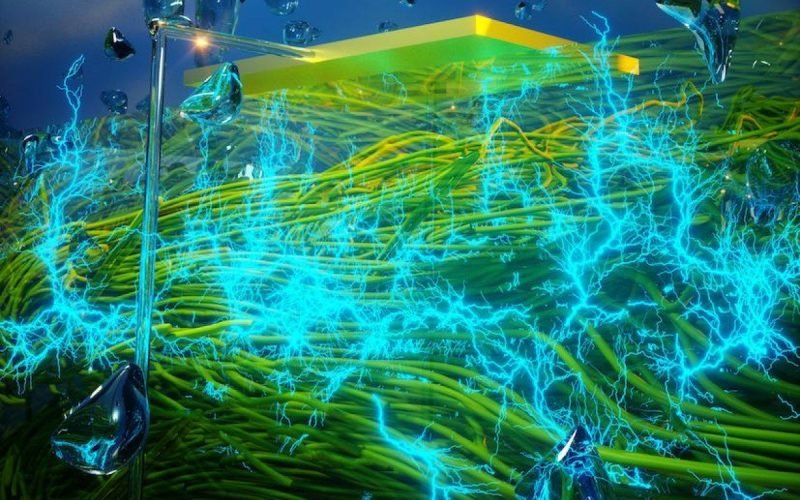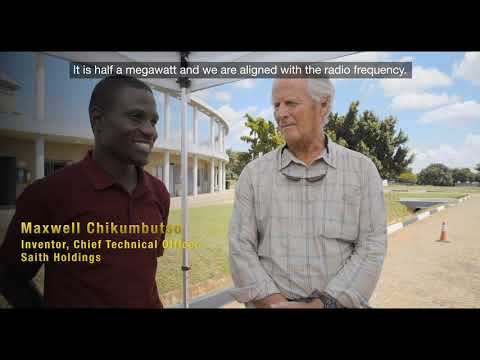
- The Facts:
- Electrical engineers from the University of Massachusetts Amherst have created a device that literally generates energy out of thin air. The creators state that ultimate goal is to make large-scale systems. For example, the technology might be incorporated into wall paint that could help power your home, for example.
- Reflect On: Why do none of the truly "free" energy sources we keep hearing about never come to market?
A study published in Nature in February 2020 entitled "Power generation from ambient humidity using protein nanowires" discovered an interesting way to harvest energy from the environment, creating the potential for another clean power generating system that is self-sustaining. According to the authors,
"Thin-film devices made from nanometre-scale protein wires harvested from the microbe Geobacter sulfurreducens can generate continuous electric power in the ambient environment. The devices produce a sustained voltage of around 0.5 volts across a 7-micrometre-thick film, with a current density of around 17 microamperes per square centimetre. We find the driving force behind this energy generation to be a self-maintained moisture gradient that forms within the film when the film is exposed to the humidity that is naturally present in air."
The study also mentions that "connecting several devices linearly scales up the voltage and current to power electronics" and that their results "demonstrate the feasibility of a continuous energy-harvesting strategy that is less restricted by location or environmental conditions than other sustainable approaches."
So, how is this all possible? Well, more than three decades ago a "sediment organism" was discovered in the Potomac river that could do things nobody had ever observed before in bacteria. The microbe belonged to the Geobactergenus, and over time scientists discovered that it could make bacterial nanowires that conduct electricity.
Electricity Out Of Thin Air
According to the team that published the study, their device uses this finding to create electricity from the atmosphere. One of the electrical engineers, Jun Yao, from the University of Massachusetts Amherst, stated that they are "literally making electricity out of thin air." They are calling it the "Air-gen" and it generates clean energy 24/7, thanks to the electrically conductive protein nanowires produced by Geobacter.
The idea that a device can create energy with nothing but the presence of air around it is quite exciting, it works by using a thin film of the protein nanowires mentioned measuring just micrometres thick that are positioned between two electrodes that are also exposed to the air. It's because of this exposure that the nanowire film is able to absorb the water vapour that's abundant within the atmosphere. This is what allows the device to generate a continuous electric current.
"The new technology developed in Yao's lab is non-polluting, renewable and low-cost. It can generate power even in areas with extremely low humidity such as the Sahara Desert. It has significant advantages over other forms of renewable energy including solar and wind, Lovley says, because unlike these other renewable energy sources, the Air-gen does not require sunlight or wind, and "it even works indoors."The researchers say that the current generation of Air-gen devices are able to power small electronics, and they expect to bring the invention to commercial scale soon. Next steps they plan include developing a small Air-gen "patch" that can power electronic wearables such as health and fitness monitors and smart watches, which would eliminate the requirement for traditional batteries. They also hope to develop Air-gens to apply to cell phones to eliminate periodic charging.
Yao says, "The ultimate goal is to make large-scale systems. For example, the technology might be incorporated into wall paint that could help power your home. Or, we may develop stand-alone air-powered generators that supply electricity off the grid. Once we get to an industrial scale for wire production, I fully expect that we can make large systems that will make a major contribution to sustainable energy production."
An addition to the Air-gen, Yao's laboratory has created several other applications using protein nanowires that are showing strong potential. Apparently this is just the beginning in a new era of protein-based electronic devices-if this technology is actually allowed to fully develop.
Human beings have so much potential, and we've had solutions to many of our problems for quite some time. Developments like this never seem to come to commercial scale as promised, and are not really 'put out there' nor marketed as they should be.
Another Groundbreaking Example
Sangulani (Maxwell) Chikumbutso has invented an electric system that runs off a battery that charges itself with electromagnetic radiation that's present naturally in the environment. It can run forever.
According to Maxwell's claims, the energy to power the battery is taken from electromagnetic waves that exist all around us and are naturally present in our environment. The vehicle had 5 normal gel batteries which were sufficient enough to start the vehicle and charge the batteries, and from there on in, the batteries are constantly charging.
His story and developments began to make noise. For example, SABC News, a major news station owned by the South African Broadcasting Corporation An electric car that does not require conventional recharging to their viewers.
According to the Zambian Observer,
"The United States government has given Zimbabwe's prolific inventor Maxwell Chikumbutso a new home in its populous state of California. Chikumbutso is the founder of Saith Holdings Inc. under which he made headlines for his serial innovations which include the world's first ever green power generator which can produce electricity using radio frequencies, an electric powered car which doesn't consume fuel, a fuelled helicopter and many more."
When this story broke, a number of " fact-checkers" simply labelled it as false without any investigation. When I first saw this I thought to myself, why would multiple media outlets cover the story, film it and present it to the entire country if it was fake? And why did fact checkers simply label the story as false from the armchairs of their offices without providing any evidence showing that it was?
Despite fact-checkers labelling this information as false without any investigation, new energy enthusiasts and makers of one of the most viewed documentaries in human history, THRIVE: What on Earth Will It Take, Foster Gamble and Kimberly Carter Gamble decided to actually go to Zimbabwe and vet the technology for themselves. Since Foster has been looking into and studying new energy technologies for more than 30 years, this was both an exciting moment but one filled with careful consideration, as the vast majority of claims like this are in fact false.
The Thrive team met Maxwell when they landed, and quickly sensed that Maxwell was a good hearted soul who has the desire the change the world. But did his technology truly work? The next morning, Maxwell took them to see a device, which uses the same technology behind the electric car mentioned above. The unit shown in the video clip below is ample enough to power 300 homes, continuously, forever. Likely with maintenance of course. Think about the implications of that...
The full story and more is covered in their new film, Thrive II: This Is What It Takes. You can see a brief clip from THRIVE II below and Foster and Kimberly's interaction with Maxwell.
